
Gothic architecture is an architectural style that was prevalent in Europe from the late 12th to the 16th century, during the High and Late Middle Ages, surviving into the 17th and 18th centuries in some areas. It evolved from Romanesque architecture and was succeeded by Renaissance architecture. It originated in the Île-de-France and Picardy regions of northern France. The style at the time was sometimes known as opus Francigenum ; the term Gothic was first applied contemptuously during the later Renaissance, by those ambitious to revive the architecture of classical antiquity.

Islamic architecture comprises the architectural styles of buildings associated with Islam. It encompasses both secular and religious styles from the early history of Islam to the present day. The Islamic world encompasses a wide geographic area historically ranging from western Africa and Europe to eastern Asia. Certain commonalities are shared by Islamic architectural styles across all these regions, but over time different regions developed their own styles according to local materials and techniques, local dynasties and patrons, different regional centers of artistic production, and sometimes different religious affiliations.

An ogive is the roundly tapered end of a two- or three-dimensional object. Ogive curves and surfaces are used in engineering, architecture, woodworking, and ballistics.

A rib vault or ribbed vault is an architectural feature for covering a wide space, such as a church nave, composed of a framework of crossed or diagonal arched ribs. Variations were used in Roman architecture, Byzantine architecture, Islamic architecture, Romanesque architecture, and especially Gothic architecture. Thin stone panels fill the space between the ribs. This greatly reduced the weight and thus the outward thrust of the vault. The ribs transmit the load downward and outward to specific points, usually rows of columns or piers. This feature allowed architects of Gothic cathedrals to make higher and thinner walls and much larger windows.
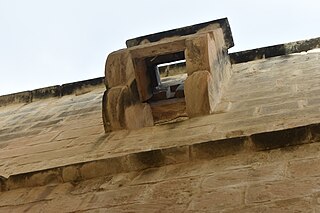
A machicolation is a floor opening between the supporting corbels of a battlement, through which stones or other material, such as boiling water, hot sand, quicklime or boiling cooking oil, could be dropped on attackers at the base of a defensive wall. A smaller version found on smaller structures is called a box-machicolation.

The Mosque–Cathedral of Córdoba, officially known by its ecclesiastical name of Cathedral of Our Lady of the Assumption, is the cathedral of the Diocese of Córdoba dedicated to the Assumption of Mary and located in the Spanish region of Andalusia. Due to its status as a former mosque, it is also known as the Mezquita and as the Great Mosque of Córdoba.
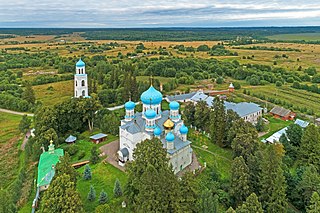
An onion dome is a dome whose shape resembles an onion. Such domes are often larger in diameter than the tholobate (drum) upon which they sit, and their height usually exceeds their width. They taper smoothly upwards to a point.
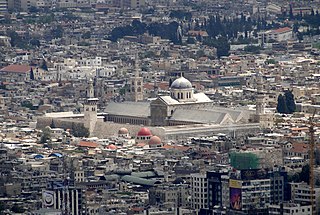
The Umayyad Mosque, also known as the Great Mosque of Damascus, located in the old city of Damascus, the capital of Syria, is one of the largest and oldest mosques in the world. Its religious importance stems from the eschatological reports concerning the mosque, and historic events associated with it. Christian and Muslim tradition alike consider it the burial place of John the Baptist's head, a tradition originating in the 6th century. Two shrines inside the premises commemorate the Islamic prophet Muhammad's grandson Husayn ibn Ali, whose martyrdom is frequently compared to that of John the Baptist and Jesus.
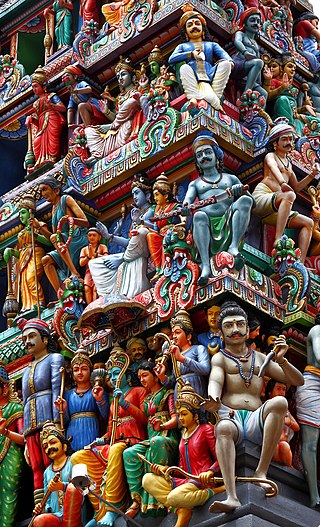
Sacral architecture is a religious architectural practice concerned with the design and construction of places of worship or sacred or intentional space, such as churches, mosques, stupas, synagogues, and temples. Many cultures devoted considerable resources to their sacred architecture and places of worship. Religious and sacred spaces are amongst the most impressive and permanent monolithic buildings created by humanity. Conversely, sacred architecture as a locale for meta-intimacy may also be non-monolithic, ephemeral and intensely private, personal and non-public.

Crusader art or the art of the Crusades, meaning primarily the art produced in Middle Eastern areas under Crusader control, spanned two artistic periods in Europe, the Romanesque and the Gothic, but in the Crusader kingdoms of the Levant the Gothic style barely appeared. The military crusaders themselves were mostly interested in artistic and development matters, or sophisticated in their taste, and much of their art was destroyed in the loss of their kingdoms so that only a few pieces survive today. Probably their most notable and influential artistic achievement was the Crusader castles, many of which achieve a stark, massive beauty. They developed the Byzantine methods of city-fortification for stand-alone castles far larger than any constructed before, either locally or in Europe.

Selimiye Mosque, historically known as Cathedral of Saint Sophia or Ayasofya Mosque, is a former Christian cathedral converted into a mosque, located in North Nicosia. It has historically been the main mosque on the island of Cyprus. The Selimiye Mosque is housed in the largest and oldest surviving Gothic church in Cyprus possibly constructed on the site of an earlier Byzantine church.

A multifoil arch, also known as a cusped arch, polylobed arch, or scalloped arch, is an arch characterized by multiple circular arcs or leaf shapes that are cut into its interior profile or intrados. The term foil comes from the old French word for "leaf." A specific number of foils is indicated by a prefix: trefoil (three), quatrefoil (four), cinquefoil (five), sexfoil (six), octofoil (eight). The term multifoil or scalloped is specifically used for arches with more than five foils. The multifoil arch is characteristic of Islamic art and architecture; particularly in the Moorish architecture of al-Andalus and North Africa and in Mughal architecture of the Indian subcontinent. Variants of the multifoil arch, such as the trefoil arch, are also common in other architectural traditions such as Gothic architecture.

A four-centred arch or four-centered arch is a low, wide type of arch with a pointed apex. Its structure is achieved by drafting two arcs which rise steeply from each springing point on a small radius, and then turning into two arches with a wide radius and much lower springing point. It is a pointed sub-type of the general flattened depressed arch. This type of arch uses space efficiently and decoratively when used for doorways. It is also employed as a wall decoration in which arcade and window openings form part of the whole decorative surface. Two of the most notable types are known as the Persian arch, which is moderately "depressed" and found in Islamic architecture, and the Tudor arch, which is much flatter and found in English architecture. Another variant, the keel arch, has partially straight rather than curved sides and developed in Fatimid architecture.

The Great Mosque of Aleppo is the largest and one of the oldest mosques in the city of Aleppo, Syria. It is located in al-Jalloum district of the Ancient City of Aleppo, a World Heritage Site, near the entrance to Al-Madina Souq. The mosque is purportedly home to the remains of Zechariah, the father of John the Baptist, both of whom are revered in Islam and Christianity. It was built in the beginning of the 8th century CE. However, the current building dates back to the 11th through 14th centuries. The minaret in the mosque was built in 1090, and was destroyed during fighting in the Syrian Civil War in April 2013.

The horseshoe arch, also called the Moorish arch and the keyhole arch, is a type of arch in which the circular curve is continued below the horizontal line of its diameter, so that the opening at the bottom of the arch is narrower than the arch's full span. Evidence for the earliest uses of this form are found in Late Antique and Sasanian architecture, but it became emblematic of Islamic architecture, especially Moorish architecture. It also made later appearances in Moorish Revival and Art Nouveau styles. Horseshoe arches can take rounded, pointed or lobed form.
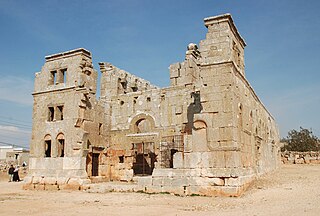
Qalb Loze is a Druze village in northwestern Syria, administratively part of the Idlib Governorate located about 35 kilometres (22 mi) west of Aleppo. It is situated near the border with Turkey, in the A'la Mountain and is part of an area known as the "Dead Cities". According to the Syria Central Bureau of Statistics (CBS), Qalb Loze had a population of 1,290 in the 2004 census.

Islamic influences on Western art refers to the stylistic and formal influence of Islamic art, defined as the artistic production of the territories ruled by Muslims from the 7th century onward, on European Christian art. Western European Christians interacted with Muslims in Europe, Africa, and the Middle East and formed a relationship based on shared ideas and artistic methods. Islamic art includes a wide variety of media including calligraphy, illustrated manuscripts, textiles, ceramics, metalwork, and glass, and because the Islamic world encompassed people of diverse religious backgrounds, artists and craftsmen were not always Muslim, and came from a wide variety of different backgrounds. Glass production, for example, remained a Jewish speciality throughout the period. Christian art in Islamic lands, such as that produced in Coptic Egypt or by Armenian communities in Iran, continued to develop under Islamic rulers.
Taybat al-Imam is a town in northern Syria, administratively part of the Hama Governorate, located 18 kilometers northwest of Hama. Nearby localities include Halfaya and Mhardeh to the west, Lataminah to the northwest, Mork to the north, Suran to the east, Maar Shahhur to the southeast, Qamhana to the south and Khitab to the southwest. According to the Syria Central Bureau of Statistics (CBS), Taybat al-Imam had a population of 24,105 in the 2004 census. Its inhabitants are predominantly Sunni Muslims.
Diana Darke is an author, Middle East cultural writer, Arabist and occasional BBC broadcaster. Her work has appeared in the Guardian, the Financial Times, the Sunday Times, the Daily Telegraph and Al Araby. She graduated from Wadham College, Oxford, in 1977, where she studied German and Philosophy/Arabic, then went on to work for the British Government Communications Headquarters (GCHQ) and Racal Electronics Plc as an Arabic consultant. In 2005, Darke purchased a 17th-century courtyard house in the Old City of Damascus.
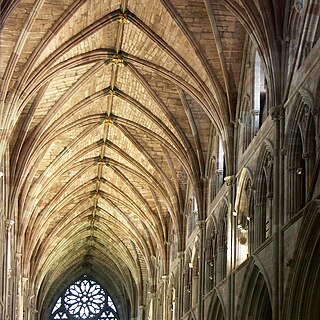
A pointed arch, ogival arch, or Gothic arch is an arch with a pointed crown meet at an angle at the top of the arch. Also known as a two-centred arch, its form is derived from the intersection of two circles. This architectural element was particularly important in Gothic architecture. The earliest use of a pointed arch dates back to bronze-age Nippur. As a structural feature, it was first used in eastern Christian architecture, Byzantine architecture and Sasanian architecture, but in the 12th century it came into use in France and England as an important structural element, in combination with other elements, such as the rib vault and later the flying buttress. These allowed the construction of cathedrals, palaces and other buildings with dramatically greater height and larger windows which filled them with light.





















